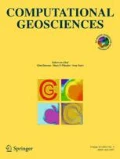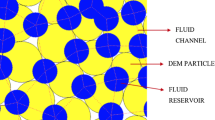Abstract
In this paper, the applicability of a mesh-free method, called smoothed particle hydrodynamics (SPH), to modelling of geological and mineral system formation is explored, focusing on rock fracture development associated with a magmatic intrusion. A generic geological system that represents a magmatic body intruded into upper-crustal rocks typical of the Yilgarn Craton of Western Australia is modelled using SPH in order to explore patterns of fracture development around such a body. The SPH method is first validated via a uniaxial test problem. A coupled elastic deformation-fluid flow-thermal analysis is conducted to model the fracturing of rocks surrounding the magmatic intrusion, including the effects of pre-tensile and pre-compressive geotechnical strains in the rocks. The SPH method was found to be effective in capturing discrete fracturing processes caused by intruding magma which cannot be easily simulated using the finite element method (FEM). The SPH model predicted fracture patterns in the rocks that were found to compare well with geological structures observed in nature. This study establishes SPH as a useful computational tool to understand the influence of intruding magmas on rock deformation and fracture development that has important implications on fracture and vein formation, magma and fluid flow migration and hence associated mineralisation.
Similar content being viewed by others
References
Groves, D.I., Goldfarb, R.J., Knox-Robinson, C.M., Ojala, J., Gardoll, S., Yun, G.Y., Holyland, P.: Late-kinematic timing of orogenic gold deposits and significance for computer-based exploration techniques with emphasis on the Yilgarn Block, Western Australia. Ore Geol. Rev. 17(1–2), 1–38 (2000)
Goldfarb, R.J., Groves, D.I., Gardoll, S.: Orogenic gold and geologic time: a global synthesis. Ore Geol. Rev. 18(1–2), 1–75 (2001)
Henson, P.A., Blewett, R.S., Champion, D.C., Goleby, B.R., Czarnota, K.: How does the 3D architecture of the Yilgarn control hydrothermal fluid focusing? In: Henson, P.A., Blewett, R.S., Champion, D.C., Goleby, B.R., Czarnota, K. (eds.) Kalgoorlie 07 Conference, in WA, pp 57–61. Geoscience Australia (2007)
Blewett, R.S., Czarnota, K., Henson, P.A.: Structural-event framework for the eastern Yilgarn Craton, Western Australia, and its implications for orogenic gold. Precambrian Research 183(2), 203–229 (2010)
Duuring, P., Hagemann, S.G., Groves, D.I.: Structural setting, hydrothermal alteration, and gold mineralisation at the Archaean syenite-hosted Jupiter deposit, Yilgarn Craton, Western Australia. Miner. Deposita 35(5), 402–421 (2000)
Sheldon, H.A.: Simulation of magmatic and metamorphic fluid production coupled with deformation, fluid flow and heat transport. Comput. Geosci. 35, 2275–2281 (2009). Compendex
Schaubs, P.M., Rawling, T.J., Dugdale, L.J., Wilson, C.J.L.: Factors controlling the location of gold mineralisation around basalt domes in the stawell corridor: insights from coupled 3D deformation-fluid flow numerical models. Australian Journal of Earth Sciences: An International Geoscience Journal of the Geological Society of Australia 53(5), 841–862 (2006)
Sorjonen-Ward, P., Zhang, Y., Zhao, C.: Numerical modelling of orogenic processes and gold mineralisation in the southeastern part of the Yilgarn Craton, Western Australia. Aust. J. Earth Sci. 49(6), 935–964 (2002)
Zhang, Y., Sorjonen-Ward, P., Ord, A., Southgate, P.N.: Fluid Flow during deformation associated with structural closure of the Isa Superbasin at 1575 Ma in the Central and Northern Lawn Hill Platform, Northern Australia. Econ. Geol. 101(6), 1293–1312 (2006)
Zhang, Y., Lin, G., Roberts, P., Ord, A.: Numerical modelling of deformation and fluid flow in the Shuikoushan district, Hunan Province, South China. Ore Geol. Rev. 31(1–4), 261–278 (2007)
Das, R., Cleary, P.W.: Modelling brittle fracture and fragmentation of a column during projectile impact using a mesh-free method. In: 6th International Conference on CFD in Oil & Gas, Metallurgical and Process Industries in Trondheim, Norway (2008)
Das, R., Cleary, P.W.: Modelling 3D fracture and fragmentation in a thin plate under high velocity projectile impact using SPH. In 3rd SPHERIC workshop, in Lausanne, Switzerland (2008)
Larsson, R., Fagerstrom, M.: A framework for fracture modelling based on the material forces concept with XFEM kinematics. Int. J. Numer. Methods Eng. 62, 1763–1788 (2005). Compendex
Gray, J.P., Monaghan, J.J.: Numerical modelling of stress fields and fracture around magma chambers. J. Volcanol. Geotherm. Res. 135, 259–283 (2004)
Cleary, P., Ha, J., Alguine, V., Nguyen, T.: Flow modelling in casting processes. Appl. Math. Model. 26(2), 171–190 (2002)
Cleary, P.W., Prakash, M., Ha, J., Stokes, N., Scott, C.: Smooth particle hydrodynamics: status and future potential. Progress in Computational Fluid Dynamics 7(2–4), 70–90 (2007)
Monaghan, J.J.: Smoothed particle hydrodynamics. Ann. Rev. Astron. Astrophys. 30, 543–574 (1992)
Monaghan, J.J.: Simulating free surface flows with SPH. J. Computat. Phys. 110, 399–406 (1994)
Kulasegaram, S., Bonet, J., Lewis, R.W., Profit, M.: High pressure die casting simulation using a Lagrangian particle method. Commun. Numer. Methods Eng. 19(9), 679–687 (2003)
Cedric, T., Janssen, L.P.B.M., Pep, E.: Smoothed particle hydrodynamics model for phase separating fluid mixtures. I. General equations. Physical Review E (Statistical Nonlinear, and Soft Matter Physics) 72(1), 016713 (2005)
Cleary, P.W., Ha, J., Prakash, M., Nguyen, T.: 3D SPH flow predictions and validation for high pressure die casting of automotive components. Appl. Math. Model. 30(11), 1406–1427 (2006)
Fang, J., Owens, R.G., Tacher, L., Parriaux, A.: A numerical study of the SPH method for simulating transient viscoelastic free surface flows. J. Non-Newtonian Fluid Mech. 139(1–2), 68–84 (2006)
Imaeda, Y., Inutsuka, S.-i.: Shear flows in smoothed particle hydrodynamics. The Astrophysical Journal 569(1), 501–518 (2002)
Cleary, P.W., Sinnott, M., Morrison, R.: Prediction of slurry transport in SAG mills using SPH fluid flow in a dynamic DEM based porous media. Miner. Eng. 19(15), 1517–1527 (2006)
Cleary, P.W., Ha, J.: Three-dimensional smoothed particle hydrodynamics simulation of high pressure die casting of light metal components. J. Light. Met. 2(3 SPEC.), 169–183 (2002)
Cleary, P.W.: Modelling confined multi-material heat and mass flows using SPH. Appl. Math. Model. 22(12), 981–993 (1998)
Cleary, P.W., Monaghan, J.J.: Conduction modelling using smoothed particle hydrodynamics. J. Comput. Phys. 148(1), 227–264 (1999)
Cleary, P.W., Prakash, M., Ha, J.: Novel applications of smoothed particle hydrodynamics (SPH) in metal forming. J. Mater. Process. Technol. 177(1–3), 41–48 (2006)
Gray, J.P., Monaghan, J.J., Swift, R.P.: SPH elastic dynamics. Comput. Methods Appl. Mech. Eng. 190(49–50), 6641–6662 (2001)
Libersky, L.D., Petschek, A.G.: Smooth particle hydrodynamics with strength of materials. In: Trease, H.E., Crowley, W.P. (eds.) Advances in the free-lagrange method. Springer, Berlin (1990)
Liu, Z.S., Swaddiwudhipong, S., Koh, C.G.: High velocity impact dynamic response of structures using SPH method. Int. J. Comput. Eng. Sci. 5(2), 315–326 (2004)
Strength modeling in SPHC. Wingate, C.A., and Fisher, H.N., 1993. Los Alamos National Laboratory, Report No. LA-UR-93-3942
Cleary, P.W., Prakash, M., Sinnott, M.D., Rudman, M., Das, R.: Large scale simulation of industrial, engineering and geophysical flows using particle methodsmethods. In: Onate, R.O.A.E. (ed.) Particle methods (Selected papers from Proceedings of Particles 2009 conference). Springer (2010)
Cleary, P.W.: Elastoplastic deformation during projectile-wall collision. Appl. Math. Model. 34(2), 266–283 (2010)
Tunsakul, J., Jongpradist, P., Soparat, P., Kongkitkul, W., Nanakorn, P.: Analysis of fracture propagation in a rock mass surrounding a tunnel under high internal pressure by the element-free Galerkin method. Comput. Geotech. 55, 78–90 (2014)
Das, R., Cleary, P.W.: The potential for SPH modelling of solid deformation and fracturefracture. In: Reddy, D. (ed.) IUTAM Proceedings Book Series Volume on Theoretical, Computational and Modelling Aspects of Inelastic Media. Springer, Capetown (2008)
Das, R., Cleary, P.W.: Effect of rock shapes on brittle fracture using smoothed particle hydrodynamics. Theor. Appl. Fract. Mech. 53, 47–60 (2010)
Karekal, S., Das, R., Mosse, L., Cleary, P.W.: Application of a mesh-free continuum method for simulation of rock caving processes. International Journal of Rock Mechanics and Mining Sciences 48(5), 703–711 (2011)
Balmforth, N.J., Burbidge, A.S., aster, R.V., Salzig, J., Shen, A.: Visco-plastic models of isothermal lava domes. J. Fluid Mech. 403, 37–65 (2000)
Herschel, W.H., Bulkley, R.: Uber die viskositat und Elastizitat von Solen. American Society of Testing Materials 26, 621–633 (1923)
Monaghan, J.J.: Smoothed particle hydrodynamics. Rep. Prog. Phys. 68, 1703–1759 (2005)
Cocchetti, G., Pagani, M., Perego, U.: Selective mass scaling and critical time-step estimate for explicit dynamics analyses with solid-shell elements. Comput. Struct. 127(0), 39–52 (2013)
Olovsson, L., Simonsson, K., Unosson, M.: Selective mass scaling for explicit finite element analyses. Int. J. Numer. Methods Eng. 63(10), 1436–1445 (2005)
Grady, D.E., Kipp, M.E.: Continuum modelling of explosive fracture in oil shale. International Journal of Rock Mechanics and Mining Sciences & Geomechanics Abstracts 17(3), 147–157 (1980)
Melosh, H.J., Ryan, E.V., Asphaug, E.: Dynamic fragmentation in impacts: hydrocode simulation of laboratory impacts. J. Geophys. Res. 97, 14735–14759 (1992)
Grady, D.E., Kipp, M.E., Smith, C.S.: Explosive fracture studies on oil shale. Soc. Pet. Eng. J. 5, 349–356 (1980)
Das, R., Cleary, P.W.: A mesh-free approach for fracture modelling of gravity dams under earthquake. Int. J. Fract. 179(1–2), 9–33 (2013)
Grady, D.E., Kipp, M.E.: Oil shale fracture and fragmentation at higher rates of loading. U.S. Symposium on Rock Mechanics, 403–406 (1979)
Thorne, B.J., Hommert, P.J., Brown, B.: Experimental and computational investigation of the fundamental mechanisms of cratering. In: 3rd International Symposium on Rock Fragmentation by Blasting, in Brisbane, pp. 117–124 (1990)
Aliabadi, M.H., Rooke, D.P.: Numerical fracture mechanics. Computational Mechanics Publications and Kluwer Academic Publishers, Boston (1991)
Fernandez-Mendez, S., Bonet, J., Huerta, A.: Continuous blending of SPH with finite elements. Comput. Struct. 83, 1448–1458 (2005)
Bradley, G.L., Chang, P.C., McKenna, G.B.: Rubber modeling using uniaxial test data. J. Appl. Polym. Sci. 81(4), 837–848 (2001)
Nawrocki, P.A., Dusseault, M.B., Bratli, R.K.: Use of uniaxial compression test results in stress modelling around openings in nonlinear geomaterials. J. Pet. Sci. Eng. 21(1–2), 79–94 (1998)
Kahraman, S., Alber, M.: Estimating unconfined compressive strength and elastic modulus of a fault breccia mixture of weak blocks and strong matrix. International Journal of Rock Mechanics and Mining Sciences 43(8), 1277–1287 (2006)
Wu, B., Tan, C.P.: Sand production prediction of gas field: methodology and laboratory verification. In: SPE Asia Pacific Oil & Gas Conference and Exhibition, in Melbourne (2002)
Turcotte, D.L., Schubert, G.: Geodynamics: applications of continuum physics to geological problems. Wiley, New York (1982)
Leitch, A.M., Weinberg, R.F.: Modelling granite migration by mesoscale pervasive flow. Earth Planet. Sci. Lett. 200(1–2), 131–146 (2002)
Büttner, R., Zimanowski, B., Blumm, J., Hagemann, L.: Thermal conductivity of a volcanic rock material (olivine-melilitite) in the temperature range between 288 and 1470 K. J. Volcanol. Geotherm. Res. 80(3–4), 293–302 (1998)
Cardoso, S.S.S., Woods, A.W.: On convection in a volatile-saturated magma. Earth Planet. Sci. Lett. 168(3–4), 301–310 (1999)
Goode, A.D.T.: Sedimentary structures and magma current velocities in the Kalka Layered Intrusion, Central Australia. J. Petrology 17(4), 546–558 (1976)
Pinkerton, H., Stevenson, R.: Methods of determining the rheological properties of magmas at sub-liquidus temperatures. J. Volcanol. Geotherm. Res. 53(1), 47–66 (1992)
Williams, D.A., Kerr, R.C., Lesher, C.M., Barnes, S.J.: Analytical/numerical modeling of komatiite lava emplacement and thermal erosion at Perseverance, Western Australia. J. Volcanol. Geotherm. Res. 110(1–2), 27–55 (2001)
Anderson, T.L.: Fracture mechanics: fundamentals and applications. CRC, Boca Raton (1991)
Author information
Authors and Affiliations
Corresponding author
Rights and permissions
About this article
Cite this article
Das, R., Zhang, Y., Schaubs, P. et al. Modelling rock fracturing caused by magma intrusion using the smoothed particle hydrodynamics method. Comput Geosci 18, 927–947 (2014). https://doi.org/10.1007/s10596-014-9437-8
Received:
Accepted:
Published:
Issue Date:
DOI: https://doi.org/10.1007/s10596-014-9437-8




